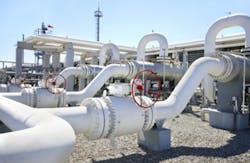Part III: The pros and cons of mass flowmeters for volumetric flow measurement
Editor’s Note: This is Part III in a five-part series discussing the types of technologies that can be applied to measure the flow of raw materials.
READ ALSO: Part I—Considering the Pros & Cons of Volumetric Flow Measurement
READ ALSO: Part II—The Pros & Cons of Velocity Meters for Volumetric Flow Measurement
Positive displacement flowmeters that measure the actual volume of the fluid passing through the flowmeter (volumetric flow) and flowmeters that measure fluid velocity were discussed in previous articles (May and June 2015). These technologies measure and infer (respectfully) the volume of the fluid passing through the flowmeter. However, the amount of the fluid contained in a given volume passing through the flowmeter can vary with fluid density where the fluid density is dependent upon the fluid pressure, temperature and/or composition. Gas applications can pose significant measurement challenges due to significant density changes that can occur in many applications.
Mass flowmeters can be used to measure the mass of the fluid passing through the flowmeter. Coriolis mass flowmeters use the properties of mass to measure mass flow while thermal flowmeters utilize the thermal properties of the fluid to measure mass flow. Positive displacement and velocity flowmeters that measure and infer volumetric flow can be used to infer mass flow by multiplying the volumetric flow by the fluid density.
However, in many applications (especially gases), the desired measurement is the amount of fluid passing though the flowmeter that can be commonly described as a mass — not as a volume. Stated differently, the commonly desired measurement is the mass flow of the fluid — not its measured or inferred volume.
It would be logical to presume that mass flowmeters should be utilized in most flow measurement installations. However, cost constraints, process conditions, accuracy requirements, and relatively small operating density variations in many applications (especially liquids) allow flowmeters other than mass flowmeters to be successfully applied in most flow measurement applications.
To be continued.
David W. Spitzer is a regular contributor to Flow Control magazine and a principal in Spitzer and Boyes, LLC, offering engineering, training, strategic marketing consulting, distribution consulting, and expert witness services for manufacturing and automation companies. Spitzer and Boyes is also the publisher of the Industrial Automation INSIDER. Mr. Spitzer has more than 40 years of experience and has written more than 10 books and 300 articles about flow measurement, instrumentation and process control. David can be reached at +1.845.623.1830 or via www.spitzerandboyes.com. Click on the "Products" tab to find his Consumer Guides to various flow and level measurement technologies.
David W. Spitzer
David W Spitzer’s new book Global Warming (aka Climate Change): An Understandable Data-Driven Explanation and Pathway to Mitigation (Amazon.com) adds to his over 500 technical articles and 10 books on flow measurement, instrumentation, process control and variable speed drives. David offers consulting services and keynote speeches, writes/edits white papers, presents seminars, and provides expert witness services at Spitzer and Boyes LLC (spitzerandboyes.com or +1.845.623.1830).



